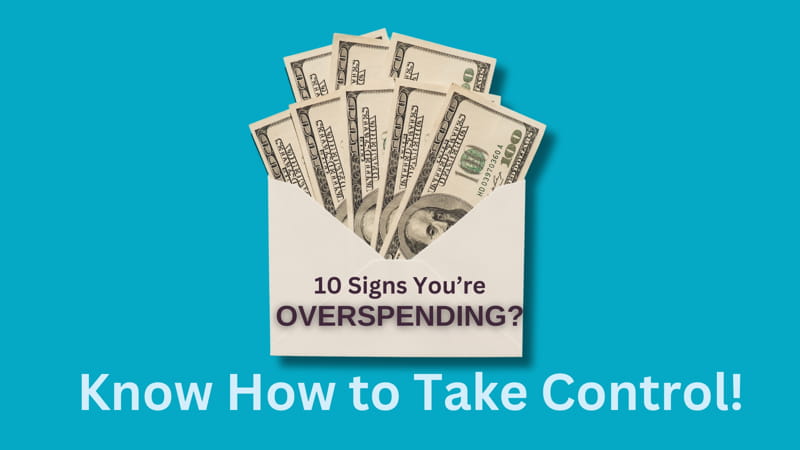Introduction
Do you often find yourself wondering where your paycheck went? You’re not alone. According to a 2024 survey by CNBC, 65% of Americans live paycheck to paycheck, and 40% admit to overspending regularly. Overspending can lead to debt, stress, and financial instability. But how do you know if you’re spending beyond your means?
In this blog, we’ll explore 10 clear signs that you’re overspending and provide practical solutions to help you regain control of your finances. Whether you’re struggling with credit card debt or just want to save more, this guide is for you.
10 Signs You’re Spending Beyond Your Means
1. You Have Little to No Savings
If your savings account is consistently empty, it’s a red flag. The Federal Reserve reports that 28% of Americans have no emergency savings at all.
How to Fix It:
- Automate savings with apps like Chime or Digit.
- Follow the 50/30/20 rule: 50% needs, 30% wants, 20% savings.
2. You Rely on Credit Cards for Daily Expenses
Using credit cards for groceries or bills? A Bankrate study found that 46% of credit card users carry debt month-to-month.
How to Fix It:
- Switch to cash or debit for daily spending.
- Use budgeting apps like YNAB or Mint to track expenses.
3. You Don’t Know Where Your Money Goes
If you can’t account for your spending, you’re likely overspending. A 2023 survey by Debt.com revealed that 74% of people don’t stick to a budget.
How to Fix It:
- Track every expense for 30 days using expense tracker apps.
- Categorize spending to identify problem areas.
4. You’re Paying Only the Minimum on Credit Cards
Paying only the minimum? You’re not alone. The Federal Reserve states that 55% of credit card users pay only the minimum due.
How to Fix It:
- Prioritize paying off high-interest debt first.
- Use tools like Debt Snowball or Debt Avalanche methods.
5. You Have No Budget
No budget = no control. A 2023 study by NerdWallet found that 60% of Americans don’t have a monthly budget.
How to Fix It:
- Create a budget using free budgeting apps like EveryDollar.
- Review and adjust your budget monthly.
6. You’re Constantly Stressed About Money
Financial stress is a clear sign of overspending. A CNBC survey found that 70% of Americans feel stressed about their finances.
How to Fix It:
- Identify and cut unnecessary expenses.
- Build an emergency fund to reduce stress.
7. You’re Living Paycheck to Paycheck
If you’re waiting for payday to cover bills, you’re overspending. The 2023 PYMNTS Report shows that 65% of Americans live paycheck to paycheck.
How to Fix It:
- Reduce discretionary spending (e.g., dining out, subscriptions).
- Increase income through side hustles or freelance work.
8. You Have Multiple Subscriptions You Don’t Use
The average American spends $273/month on subscriptions, many of which go unused (West Monroe Partners, 2023).
How to Fix It:
- Cancel unused subscriptions.
- Use tools like Truebill to track and manage subscriptions.
9. You’re Ignoring Bills or Overdraft Fees
Ignoring bills or incurring overdraft fees? A 2023 Bankrate study found that 25% of Americans have overdrafted their accounts.
How to Fix It:
- Set up automatic bill payments.
- Use banking apps with low-balance alerts.
10. You’re Borrowing from Savings or Retirement Accounts
Borrowing from savings or retirement accounts is a major red flag. The Transamerica Center for Retirement Studies found that 30% of workers have taken loans from their 401(k).
How to Fix It:
- Avoid tapping into retirement funds unless absolutely necessary.
- Focus on building a separate emergency fund.
How to Fix Overspending: Actionable Tips
1. Use Budgeting Apps
- Best Budgeting Apps:
- YNAB (You Need A Budget): Great for detailed budgeting.
- Mint: Tracks spending and creates budgets automatically.
- EveryDollar: Simple and user-friendly.
2. Track Your Spending
- Use expense tracker apps like PocketGuard or Goodbudget.
- Review your spending weekly to stay on track.
3. Cut Unnecessary Expenses
- Cancel unused subscriptions.
- Limit dining out and entertainment costs.
4. Build an Emergency Fund
- Aim for 3–6 months of living expenses.
- Use high-yield savings accounts like Ally Bank or Marcus by Goldman Sachs.
5. Increase Your Income
- Start a side hustle (e.g., freelancing, tutoring).
- Sell unused items online (e.g., eBay, Facebook Marketplace).
Table: Average Monthly Spending in the U.S. (2024)
| Category | Average Monthly Cost |
|---|---|
| Housing | $1,784 |
| Transportation | $819 |
| Food | $726 |
| Entertainment | $243 |
| Subscriptions | $273 |
| Healthcare | $487 |
| Utilities | $398 |
Source: Bureau of Labor Statistics, 2024
FAQs
1. What’s the best way to stop overspending?
- Create a budget, track expenses, and cut unnecessary costs.
2. How much should I save each month?
- Aim for 20% of your income, following the 50/30/20 rule.
3. What’s the best budgeting app?
- YNAB and Mint are top-rated for budgeting and expense tracking.
4. How can I reduce my credit card debt?
- Use the Debt Snowball method or transfer balances to a 0% APR card.
Conclusion
Overspending is a common problem, but it’s not insurmountable. By recognizing the 10 signs of overspending and implementing the solutions provided, you can take control of your finances. Use budgeting apps, track your expenses, and focus on building savings to achieve financial stability.
Remember, the key to financial success is awareness and action. Start today, and you’ll be on your way to a healthier financial future.
Interested to take control of your Personal Finance? Read these 10 Simple Budgeting Techniques for Beginners: Take Control of Your Finances Today and Here’s a Template for this.







